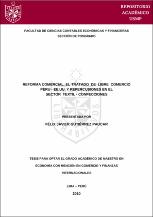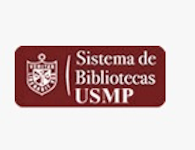Mostrar el registro sencillo del ítem
Reforma comercial, el Tratado de Libre Comercio Perú - EE.UU. y repercusiones en el Sector Textil - Confecciones
| dc.contributor.author | Gutiérrez Páucar, Félix Javier | |
| dc.creator | Gutiérrez Páucar, Félix Javier | |
| dc.date.accessioned | 2013-08-26T17:29:43Z | |
| dc.date.available | 2013-08-26T17:29:43Z | |
| dc.date.issued | 2010 | |
| dc.identifier.uri | https://hdl.handle.net/20.500.12727/355 | |
| dc.description.abstract | El año 1990 el Gobierno del Perú inicia un ambicioso proceso de Reforma Comercial con el fin de elevar la eficiencia en la asignación de recursos, integrar la economía peruana a la economía mundial y crear las condiciones para el crecimiento sostenido del producto y del empleo en el mediano plazo. Con este objetivo, se eliminaron todas las prohibiciones y restricciones a las importaciones y las medidas de promoción selectiva a sectores específicos de la economía. Se redujo significativamente el nivel y la dispersión de los aranceles, se eliminó la política de tipo de cambio múltiple y se estableció un tipo de cambio libre determinado en el mercado. Con el fin de facilitar el ajuste de la economía peruana a las nuevas condiciones de la economía internacional y permitir su crecimiento sostenido en el mediano plazo, fue indispensable continuar reduciendo el nivel y la dispersión arancelaria y eliminar “sobre costos” tributarios que aun afectaban la actividad económica. Estas medidas contribuyeron a la recuperación de las exportaciones y una integración más eficiente de la economía peruana a la economía mundial. | es_PE |
| dc.description.abstract | In 1990 the government of Peru gave beginning to an process ambitious of opening and commercial reform in order to raise the efficiency in the assignment of resources, to integrate the Peruvian economy to the world economy and to create determine it for the growth supported of the product and of the employment in the medium term. With this aim, all the prohibitions and restrictions were eliminated to the imports and the measures of selective promotion to specific sectors of the economy. There diminished significantly the level and the dispersion of the duties, eliminate the policy of type of multiple change, and there was established a type of free change determined in the market. In order to facilitate the adjustment of the Peruvian economy to the new conditions of the international economy and to allow its growth supported in the medium term, it is indispensable to continue reducing the level and the tariff dispersion and to eliminate “on costs " Tributaries who even concern the economic activity. These measures will contribute to the recovery of the exports and the most efficient integration of the Peruvian economy to the world economy.. | en_US |
| dc.language.iso | spa | es_PE |
| dc.publisher | Universidad de San Martín de Porres | es_PE |
| dc.relation.uri | http://www.repositorioacademico.usmp.edu.pe/usmp/2010/gutierrez_fj/html/index-frames.html | es_PE |
| dc.rights | info:eu-repo/semantics/openAccess | es_PE |
| dc.rights.uri | https://creativecommons.org/licenses/by-nc-nd/4.0/ | es_PE |
| dc.source | Universidad de San Martín de Porres. Programa Cybertesis PERÚ | es_PE |
| dc.source | Tesis digitales - USMP | es_PE |
| dc.subject | Industria textil | es_PE |
| dc.subject | Tratado de Libre Comercio | es_PE |
| dc.subject | Política comercial internacional | es_PE |
| dc.subject | Liberización económica | es_PE |
| dc.subject.ddc | 337 - Economía internacional | es_PE |
| dc.title | Reforma comercial, el Tratado de Libre Comercio Perú - EE.UU. y repercusiones en el Sector Textil - Confecciones | es_PE |
| dc.type | info:eu-repo/semantics/masterThesis | es_PE |
| thesis.degree.name | Magíster en Economía | es_PE |
| thesis.degree.grantor | Universidad de San Martín de Porres. Facultad de Ciencias Contables, Económicas y Financieras | es_PE |
| thesis.degree.discipline | Economía | es_PE |
| dc.publisher.country | PE | es_PE |
| dc.subject.ocde | https://purl.org/pe-repo/ocde/ford#5.02.01 | es_PE |
| renati.level | https://purl.org/pe-repo/renati/level#maestro | es_PE |
| renati.type | https://purl.org/pe-repo/renati/type#tesis | es_PE |
Ficheros en el ítem
Este ítem aparece en la(s) siguiente(s) colección(es)
-
Tesis de maestría [17]








